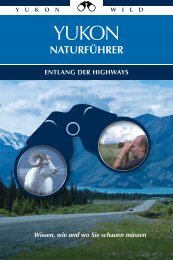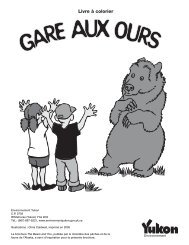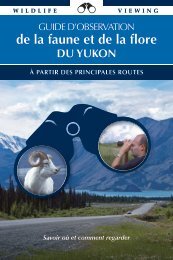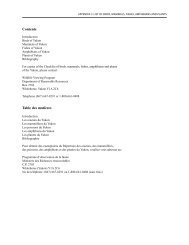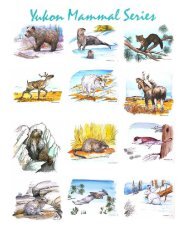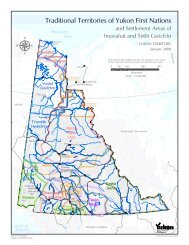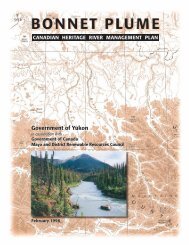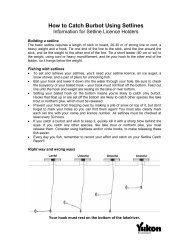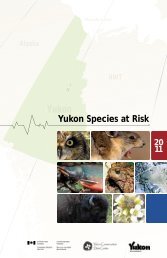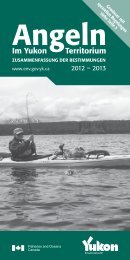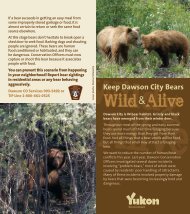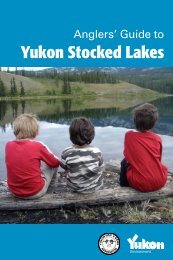Ch. 3 Land - Environment Yukon
Ch. 3 Land - Environment Yukon
Ch. 3 Land - Environment Yukon
You also want an ePaper? Increase the reach of your titles
YUMPU automatically turns print PDFs into web optimized ePapers that Google loves.
Carcross/Tagish First Nation<br />
<strong>Ch</strong>ampagne & Aishihik First Nations<br />
Kluane First Nation<br />
Kwanlin Dun First Nation<br />
Liard First Nation<br />
Little Salmon/Carmacks First Nation<br />
Nacho Nyak Dun First Nation<br />
With the devolution of land, water,<br />
mineral and forest management and<br />
resources to the <strong>Yukon</strong> government<br />
proposed for 2001, the administration<br />
and control of most land will devolve to<br />
the <strong>Yukon</strong> government. In preparation<br />
for the management of land and<br />
<strong>Yukon</strong> First Nations<br />
Ross River Dena Council<br />
Selkirk First Nation<br />
Ta’an Kwach’an Council<br />
Teslin Tlingit Council<br />
Tr’on dëk Hwëch’in First Nation<br />
Vuntut Gwitchin First Nation<br />
White River First Nation<br />
resources, the <strong>Yukon</strong> government<br />
proposes to develop mirror legislation<br />
to the federal statutes. The <strong>Yukon</strong><br />
government will also be proposing<br />
amendments to the <strong>Yukon</strong> Act to<br />
update and modernize the Act in line<br />
with devolution.<br />
Major Umbrella Final Agreement<br />
<strong>Land</strong> and Resource Management Committees and Boards<br />
■ <strong>Yukon</strong> Fish and Wildlife Management Board<br />
■ Salmon Sub-Committee<br />
■ Local Renewable Resources Councils (Recommends on fish and wildlife<br />
habitat and other renewable resources)<br />
■ <strong>Yukon</strong> Heritage Resources Board<br />
■ <strong>Yukon</strong> <strong>Land</strong> Use Planning Council (Recommends policy and priority<br />
planning regions)<br />
■ Regional <strong>Land</strong> Use Planning Commissions<br />
■ <strong>Yukon</strong> Development Assessment Board (Review of development projects)<br />
■ Kluane National Park Management Board<br />
“Let’s work side by side with traditional knowledge and the public for our<br />
future generation to be healthy and have what we’ve enjoyed in the past.<br />
I’d like to see our future was the same, to be enjoyed all our life, on this<br />
land that we live on. I’d like to see these two cultures side by side to respect<br />
each other’s knowledge.” –Roddy Blackjack, Little Salmon/Carmacks First<br />
Nation Elder<br />
Under the Umbrella Final Agreement,<br />
a number of joint government and First<br />
Nation boards and committees will<br />
contribute to the management of<br />
renewable resources, land, water, and<br />
heritage resources (see side bar).<br />
The <strong>Yukon</strong> North Slope is within the<br />
Inuvialuit Settlement Region. <strong>Environment</strong>al<br />
assessment and resource<br />
management in this region are carried<br />
out through joint Inuvialuit and<br />
government boards and committees.<br />
Management plans have been<br />
prepared to address specific wildlife and<br />
community issues as shown opposite.<br />
<strong>Environment</strong>al assessment for projects<br />
on federal lands or involving federal<br />
money or permits is the responsibility<br />
of the federal government, as are land<br />
use activities such as mining and<br />
forestry. It is expected that by 2001,<br />
environmental assessment in the <strong>Yukon</strong><br />
will take place under the Development<br />
Assessment Process (DAP). The parties<br />
are continuing to work towards<br />
completing the Development Assessment<br />
Process that fulfills the requirements<br />
of the UFA and is reflective of<br />
the needs of <strong>Yukon</strong>ers. Consultation<br />
on the next public draft of the legislation<br />
is expected to occur in 2000.<br />
3.1 Wilderness<br />
Wilderness means an area in the <strong>Yukon</strong><br />
where human activity has not<br />
significantly changed the environment<br />
or the ecosystem. It includes an area<br />
restored to natural condition (<strong>Yukon</strong><br />
<strong>Environment</strong> Act).<br />
Wilderness areas are being lost<br />
throughout the world as the human<br />
population continues to climb and the<br />
use of land and resources increases.<br />
Since 1900, the world’s population has<br />
multiplied almost fivefold and in 1999<br />
the population of the world reached six<br />
billion. Projections of the world<br />
population are 10 billion in the year<br />
2060 1. The ecological footprint of this<br />
3 4 ❧ Y U K O N S T A T E O F T H E E N V I R O N M E N T R E P O R T 1999





